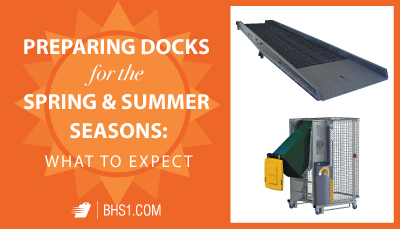We use cookies to make your experience better. To comply with the new e-Privacy directive, we need to ask for your consent to set the cookies. Learn more.
Preparing Docks for the Spring and Summer Seasons: What to Expect
The summer is nearly here, and now's a good time to start preparing docks and bays at busy distribution centers for the seasonal changes. In particular, warehouse operators should get ready for two trends that are right around the corner: Summer heat — especially at the docks — and a possible uptick in carrier traffic.

Consider how freight has been moving in spring and early summer over the past few years:
- Statistics bear out what you may have seen at warehouse docks in recent years: shipments rising as we move from spring into summer. The trends of the past few seasons could give us some clues about what to expect this year.
- According to the Bureau of Transportation Statistics' Transportation Services Index (TSI), for-hire freight shipments held relatively steady this time of year in 2015. In 2016, though, there was a 3.6 percent increase in the TSI between March and July.
- The same period in 2017 saw an increase of 3.4 percent, culminating in an all-time high for the Index in July 2017. (Subsequent months have seen that record broken.)

- Now, these figures alone don't paint a clear picture of what goes on at distribution center docks. They track the amount of freight moving within the for-hire transportation industry, but do not include parcel services, private trucking, or the U.S. Postal Service. Meanwhile, they do include railroad, inland waterways, pipelines, and air transportation, as well as trucking.
- To get a clearer picture of what to expect from trucking in particular, let's look at the Truck Tonnage Index, which measures the seasonally adjusted levels of tonnage trucks carry within the U.S.
- Those numbers tell a similar story. Between March and July of 2016, truck tonnage grew by nearly 3.5 percent. Over the same months the following year, the growth was almost 4.6 percent.
- If the trend holds for 2018, it might be time to pick up a Yard Ramp or two to account for sudden rushes at the dock.
Weather Pattern Changes that Could Affect Warehouse Dock Productivity
The boost in freight may coincide with increasing temperatures in some parts of the country, even above the typical summer sizzle. Heat can have a major impact on comfort, morale, and even productivity in the workforce. One study found that worker productivity diminishes on hot days.
The researchers estimate that each day that reaches a WetBulb Globe Temperature of 80.6 degrees (27 degrees Celsius) is associated with a worker output decrease of 4 to 9 percent. And when those temperatures stick around for more than a day at a time, each extra day of heat is associated with an increase of 1 to 2 percent in absenteeism, at least in jobs that don't penalize a few missed days of work.

Given that loading and unloading truckloads at the dock can be awfully hot work, even in the best of weather, it'd be helpful to know what to expect as the summer begins. And, as you may have guessed, current estimates suggest there could be more heat than we're used to for most of the U.S.
- The National Weather Service's' Climate Prediction Center (CPC) projects that in the South — from the southern tip of California through Arizona, New Mexico and Texas all the way to the Carolinas on the East Coast — has about a 50 percent chance of temperatures that are higher than normal in April, May, and June of this year.
- Just a bit north, a band of the country stretching from California to Oklahoma to the heart of New England is estimated to have a 40 percent chance of higher temperatures.
- Next, a swath of the country from Northern California up through the Great Lakes region and the Northeast tip of the states is looking at a 33 percent chance of extra heat.
- The rest of the continental U.S. has an equal chance of above, below, or well-within normal temperatures, according to the CPC.
So for warehouse operators, especially those in the South, this might be the time to invest in extra high-volume, low-speed fans, additional water stations, and dock-related labor-saving devices like Dockmaster Bin Tippers. Heat and extra freight may be on their way, and preparing docks for these ongoing challenges will help to keep DCs productive, no matter what the season has to offer.
References:
"Freight Transportation Services Index." StLouisFed. Federal Reserve Bank of St. Louis, 2017. Web. 12 Dec. 2017.
"July 2017 Freight Transportation Services Index (TSI)." BTS. Bureau of Transportation Statistics, 13 Sept. 2017. Web. 12 Dec. 2017.
"Monthly & Seasonal Color Outlook Maps." CPC. National Weather Service Climate Prediction Center, 17 Nov. 2017. Web. 12 Dec. 2017.
"Seasonally-Adjusted Truck Tonnage (Truck Tonnage Index)." BTS. Bureau of Transportation Statistics, Sept. 2017. Web. 12 Dec. 2017.
